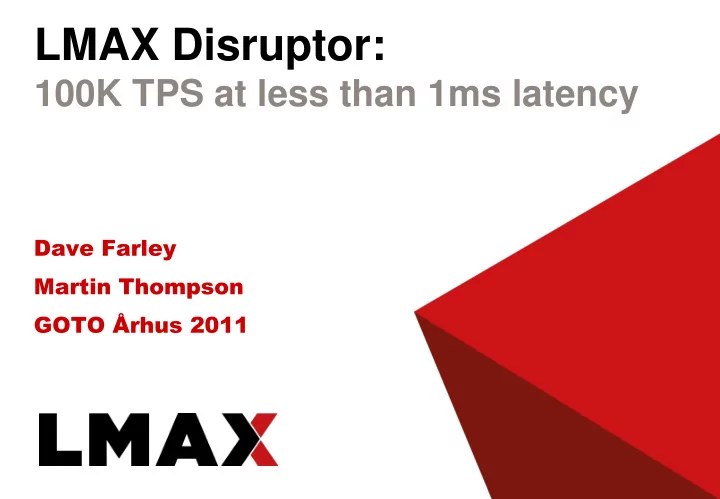

LMAX Disruptor: 100K TPS at less than 1ms latency Dave Farley Martin Thompson GOTO Århus 2011
LMAX History • Spin-off from Betfair the world’s largest sports betting exchange • Massive throughput and customer numbers • LMAX has the fastest order execution for retail trading • Institutional market makers providing committed liquidity • Real-time risk management of retail customers
X How not to solve this problem RDBMS X X J2EE SEDA X X X Actor X X Rails
Tips for high performance computing 1. Show good “Mechanical Sympathy” 2. Keep the working set In-Memory 3. Write cache friendly code 4. Write clean compact code 5. Invest in modelling your domain 6. Take the right approach to concurrency
1. Mechanical Sympathy Is it really “Turtles all the way down”? What is under all these layers of abstraction? "The most amazing achievement of the computer software industry is its continuing cancellation of the steady and staggering gains made by the computer hardware industry.“ - Henry Peteroski
2. Keep the working set In-Memory Does it feel awkward working with data remote from your address space? • Keep data and behaviour co-located • Affords rich interaction at low-latency • Enabled by 64-bit addressing
3. Write cache friendly code DRAM DRAM DRAM DRAM ~65ns DRAM DRAM QPI ~20ns MC MC L3 L3 ~45 cycles ~15ns L2 L2 L2 L2 L2 L2 L2 L2 ~12 cycles ~3ns L1 L1 L1 L1 L1 L1 L1 L1 ~4 cycles ~1ns C1 C2 C3 C4 C1 C2 C3 C4 Registers <1ns
4. Write clean compact code "Any intelligent fool can make things bigger, more complex, and more violent. It takes a touch of genius -- and a lot of courage -- to move in the opposite direction." • Hotspot likes small compact methods • CPU pipelines stall if they cannot predict branches • If your code is complex you probably do not sufficiently understand the problem domain • “Nothing in the world is truly complex other than Tax Law”
5. Invest in modelling your domain Model of an elephant based on blind men touching one part each Wall like a attached attached Rope Elephant Snake Supported By TreeTrunk • Single responsibility – One class one thing, one method one thing, etc. • Know your data structures and cardinality of relationships • Let the relationships do the work
6. Take the right approach to concurrency Concurrent programming is about 2 things: Mutual Exclusion : Protect access to contended resources Visibility of Changes : Make the results public in the correct order Locks Atomic/CAS Instructions • Context switch to the kernel • Atomic read-modify-write primitives • Can always make progress • Happen in user space • Difficult to get right • Very difficult to get right!
What is possible when you get this stuff right? On a single thread you have ~3 billion instructions per second to play with: 10K+ TPS • If you don’t do anything too stupid 100K+ TPS • With well organised clean code and standard libraries 1m+ TPS • With custom cache friendly collections • Good performance tests • Controlled garbage creation • Very well modelled domain • BTW writing good performance tests is often harder than the target code!!!
How to address the other non-functional concerns? • With a very fast business logic thread we need to feed it reliably Network Network / Archive DB Receiver HA / DR Nodes Publisher Replicator Marshaller Journaller File System Business Logic Un-Marshaller Each stage can have multiple Pipelined threads Process
Concurrent access to Queues – The Issues Link List backed size Tail Node Node Node Node Head • Hard to limit size • O(n) access times if not head or tail • Generates garbage which can be significant Array backed Tail Head size Cache line • Cannot resize easily • Difficult to get *P *C correct • O(1) access times for any slot and cache friendly
Di Disrup sruptor tor in A in Action ction Network / Archive DB Network Event Event :sequence :sequence Receiver Publisher :buffer :object :invoker :buffer 103 97 Invoke Stage n n 1 1 7 2 7 2 Business Logic 6 3 6 3 5 4 5 4 long waitFor(n) long waitFor(n) Un-Marshaller Replicator Marshaller Journaller :MIN :MIN 101 101 102 97
Disruptor – Concurrent Programming Framework Open Source project: http://code.google.com/p/disruptor/ • Very active with ever increasing performance and functionality • Wide applicability > Exchanges/Auctions, Risk Models, Network Probes, Market Data Processing, etc. How do we take advantage of multi-core? • Pin threads to cores for specific steps in a workflow or process • Pass messages/events between cores with “Mechanical Sympathy” • Understand that a “cache miss” is the biggest cost in HPC • Measure! Don’t believe everything you read and hear > Let’s bring back science in computer science!
The Disruptor Pattern Sequence Barrier Sequence Barrier Sequencer Ring Buffer < Events > EventProcessors EventProcessors Publishers CPU Core per thread
Wrap UP http://code.google.com/p/disruptor/ http://www.davefarley.net/ http://mechanical-sympathy.blogspot.com/ jobs@lmax.com
Recommend
More recommend